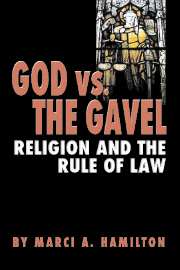Book contents
- Frontmatter
- Contents
- Acknowledgments
- Foreword, by the Hon. Edward R. Becker
- GOD VS. THE GAVEL: RELIGION AND THE RULE OF LAW
- PART ONE WHY THE LAW MUST GOVERN RELIGIOUS ENTITIES
- 1 The Problem
- 2 Children
- 3 Marriage
- 4 Religious Land Use and Residential Neighborhoods
- 5 Schools
- 6 The Prisons and the Military
- 7 Discrimination
- PART TWO THE HISTORY AND DOCTRINE BEHIND THE RULE THAT SUBJECTS RELIGIOUS ENTITIES TO DULY ENACTED LAWS
- Epilogue
- Notes
- Index
6 - The Prisons and the Military
Published online by Cambridge University Press: 24 July 2009
- Frontmatter
- Contents
- Acknowledgments
- Foreword, by the Hon. Edward R. Becker
- GOD VS. THE GAVEL: RELIGION AND THE RULE OF LAW
- PART ONE WHY THE LAW MUST GOVERN RELIGIOUS ENTITIES
- 1 The Problem
- 2 Children
- 3 Marriage
- 4 Religious Land Use and Residential Neighborhoods
- 5 Schools
- 6 The Prisons and the Military
- 7 Discrimination
- PART TWO THE HISTORY AND DOCTRINE BEHIND THE RULE THAT SUBJECTS RELIGIOUS ENTITIES TO DULY ENACTED LAWS
- Epilogue
- Notes
- Index
Summary
Terrorist networks within United States borders before September 11, 2001, were an undetected cancer spreading through the system. Our own prisons – and the military – were potential breeding grounds for extremist Muslims who believed that the United States was evil and should be eradicated. It took the annihilation of almost 3,000 victims from abroad and the U.S., including the World Trade Center – two of the tallest buildings in the world – for Americans to realize that there was a religious movement that was intent on their destruction.
In the aftermath of September 11, it quickly became apparent that Muslim chaplains in the prisons and the military were in a strategic position to recruit, train, and indoctrinate those individuals who were open or vulnerable to an approach. Like the pedophiles discussed in Chapter 2, terrorists seek out individuals who are vulnerable to their overtures – those who are isolated from family and friends – and then they play on their insecurities. The same is true for extremist gangs. John Pistole, the head of the FBI's counterterrorism division in 2003, and now its deputy director, summarized the phenomenon in the prisons like this:
Inmates are often ostracized, abandoned by, or isolated from their family and friends, leaving them susceptible to recruitment. Membership in the various radical groups offers inmates protection, positions of influence and a network they can correspond with both inside and outside of prison.
- Type
- Chapter
- Information
- God vs. the GavelReligion and the Rule of Law, pp. 141 - 172Publisher: Cambridge University PressPrint publication year: 2005



